Our barn has cement floors. It is really nice for cleaning.
The stall floors are covered in straw. In the summer we clean the stalls weekly. All that dirty straw goes into the composts bins and becomes wonderful compost for the garden.
As summer came to a close we decided that we would use the deep litter method in the stalls.
What on earth is the deep litter method?
It is a way to not have to clean stalls for months. Just joking. Ok, so it is nice to not clean stalls for months but there is actually a less selfish reason for it.
Instead of cleaning all the straw out of each stall every week we simply add fresh straw on top of the old stuff. It covers up the goat berries (aka poop) and helps to soak up the urine. Over the weeks the bottom layer of straw begins to compost. As it is rotting and breaking down it creates heat. Cement floors don’t create any heat on their own. The deep litter method creates a nice warm place for the goats to lie.
This past Saturday we decided to clean out the buck stall.
For whatever reason they drink a lot more water than the girls……which means they urinate frequently. We have to make sure they are not constantly walking in wet/damp places every day, all day. It can cause hoof rot. In Oregon that is pretty hard to do. We give them platforms to stand on in the outdoor pen and we put sawdust down on the ground to help absorb the rain.
Michael felt that it would be good to clean out the stall. It had only been four months. Deep litter can be done until the weather turns warmer. For us that would probably be at least another three months.
I said I would do it since Michael was working on another big project (sssh, it’s a secret. I’ll post when it is done. Until then, no hints!)
Joshua and Nicholas took turns working with me.
Wow! Can I just say that it certainly doesn’t come close to being as easy as the weekly summertime cleaning. By the time we were done my shoulder and lower back were in PAIN. But I racked up almost 10,000 steps on my Fit Bit.
Composting was definitely happening. So much so that it was very difficult to remove the composted bottom layer. It actually seemed as though it had rooted itself to the cement. It was a good 8 – 10 inches deep.
We used the pitch forks to lift off the top layers.
It was impossible to use the shovel so I dug down through the composting layers with the fork tines.
When I scooped to pick up the composting layers they peeled up in very big sections. It was like sod.
It was also very heavy. And gross.
In some sections the straw had already turned to dirt. In the end the stall was nice and clean.
And our compost bins were full again.
And then I soaked in a hot bath.
Have a great day,
Karen
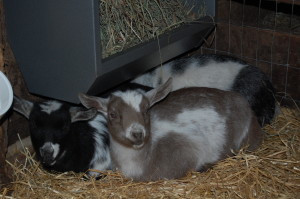
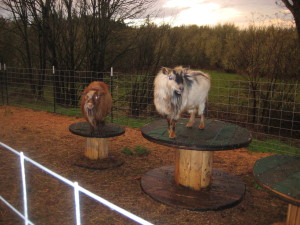
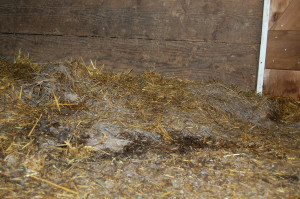
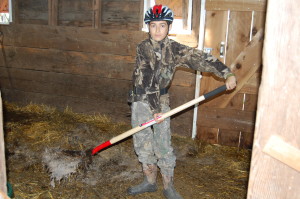
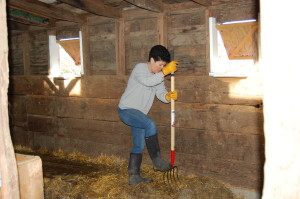
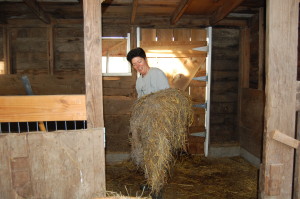
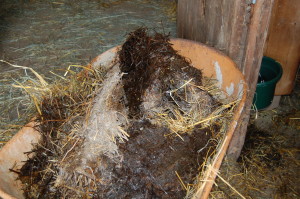
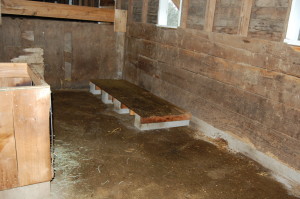
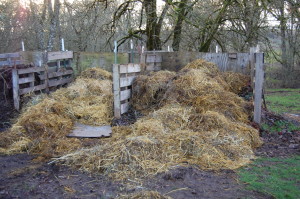
My back hurts more than usual now Karen. I think I’ll go ice it.
Less empathy my dear sister.
Have a great day,
Karen
Definitely hard work. The process makes total sense for the composting effect and adding warmth for the goats. Just a suggestion….for this project and others around a farm it would be a good idea to wear masks to avoid inhaling a lot of paticles and bacteria….and might help with the odor factor
Thanx Dee,
I actually thought about that not long after starting. Just didn’t want to quit to go get it.
I need to keep the masks in the barn (currently in the house)
Thanx for the reminder
Karen
Wow! That looks exhausting. My parents are about to embark on a journey with goats. It’s interesting reading about the compost.
I just got done “tucking the goats in” as we call it. They might be work but
they are just the cutest things and have great personalities.
I’m sure your parents will enjoy it.
Take care,
Karen
Hard work sure pays off. The barn looks so clean, the goats are happy, you and the boys got great exercise, and you’ll have some compost for your garden.
Did you hose the floor or it just looks smooth in the picture?
By the way, my male rabbits drink more water than the females. Interesting observation.
Well done. Get some rest.
Kimberly
No, this time we didn’t hose it. It was already late in the day and it would have taken too long to dry.
Interesting about the rabbits.
Take care,
Karen
Very interesting post. My goat shed has concrete floors too (previous owners had made a workshop out of it) and I’ve learned the same thing about deep litter. The composting generates lovely heat to help keep them warm!
Joel Salatin (maybe you’ve already read this) uses deep litter in his cattle barns, but for mucking them out, he scatters grain about and lets his pigs in. They loosen it all up so it’s easier to scoop out. But I think he has a front end loader, but like you, our cleaning out is all muscle power!
Yes, I told my husband about the pig option. He doesn’t want any pigs Of course there was a time (in the city) when he said he would never have chickens. Muscle power is good.
Of course there was a time (in the city) when he said he would never have chickens. Muscle power is good.
Thanx,
Karen